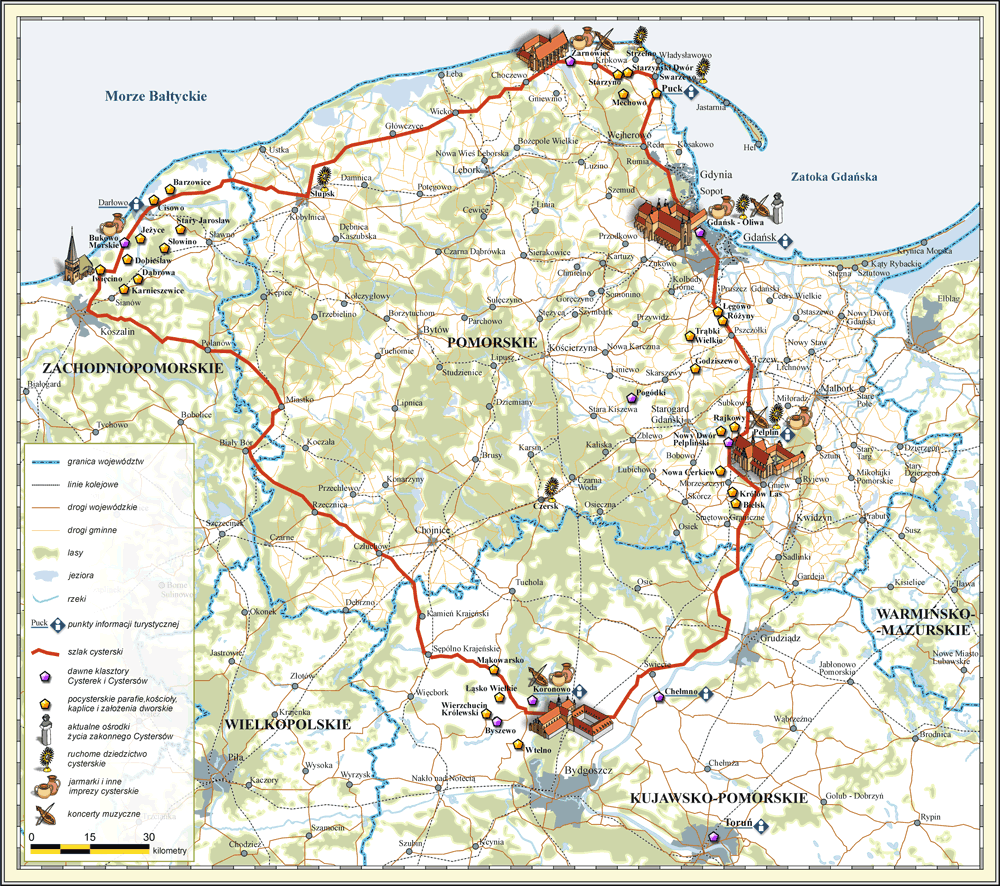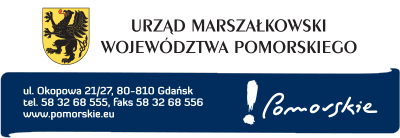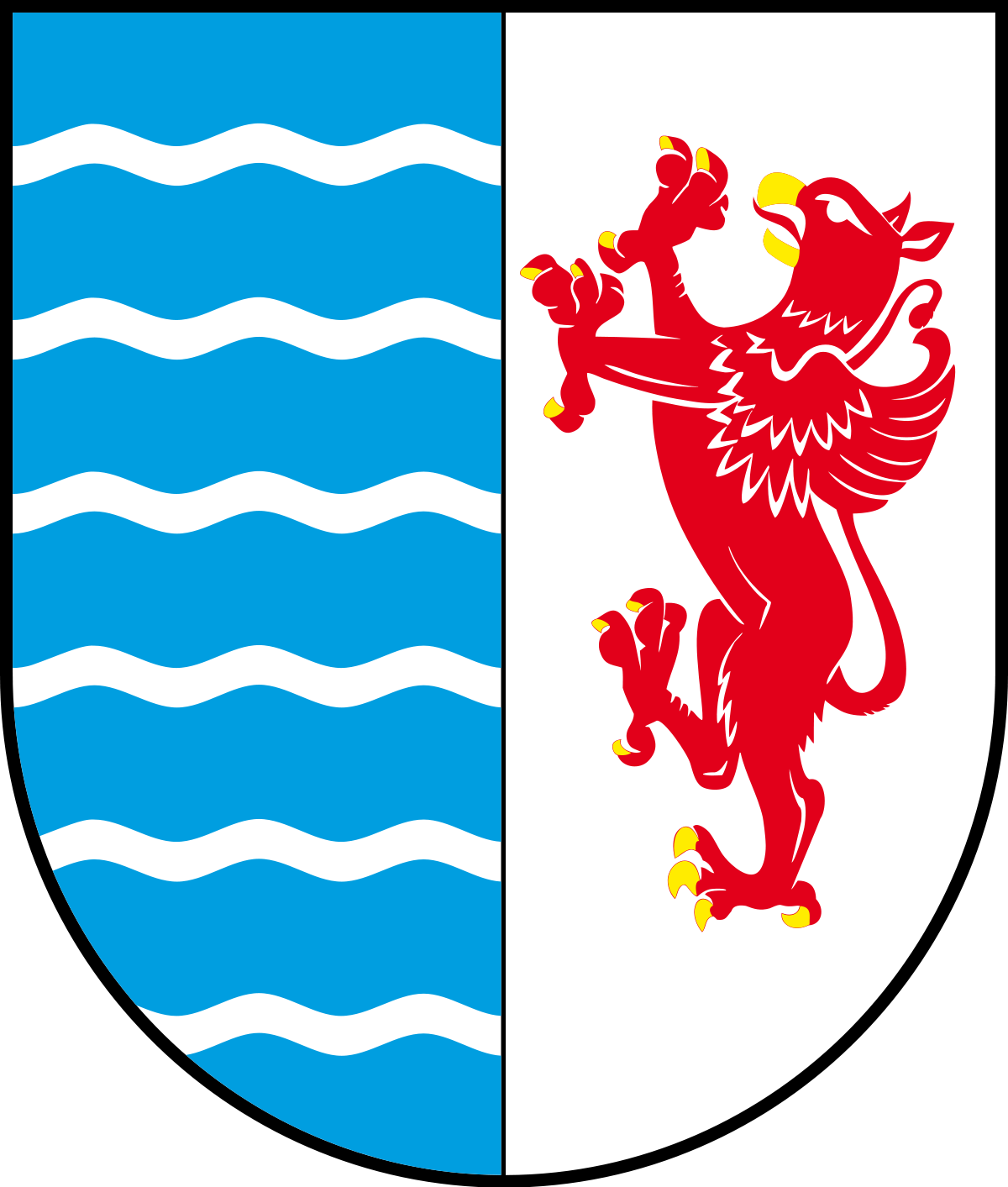Those wandering through the Pomeranian countryside are captivated by the region’s diverse landscape. However, it’s cultural richness, marked especially in architecture and art heritage of the Cistercian Order. The Grey Monks, as the Cistercians were commonly called, made a significant contribution to the development of Pomeranian culture. It is obvious to every tourist and pilgrim visiting the sites of the Pomeranian Cistercian Trail, starting from Iwięcin and Bukowo near the sea, through Żarnowiec, Oliwa, Pelplin, Byszewo, Koronowo, Chełmno and Toruń. In addition to these former abbeys, one can also visit smaller sites, mainly churches founded by the Cistercians, including Iwięcin, Starzyn, Mechowo, Pogódki, Nowa Cerkiew and Łęgowo; chapels such as in Nowy Dwór near Pelplin, or the remains of former centres, for example in Starzyński Dwór.
One travels along the Cistercian trail by car as well as by cycling, canoeing and hiking trails, not only to admire the pearls of the Gothic architecture (the cathedrals in Oliwa and Pelplin) but also surrender to the spiritual charm and silence and the monastic sites in Żarnowiec and Chełmno. To this day, more than two hundred villages once manager by Cistercian or Cistercian nuns were inventoried on the Pomeranian Cistercian Trail. In the magnificently preserved architectural structures of the churches, the soaring vaults make you raise your eyes high up to admire, as the Cistercians did – looking up at the sky and really touching the ground … their thriftiness in the monastery buildings with the remains of the old smithies, water mills, weirs, granaries or abbey palaces in the gardens.
Among the many works of art. In the furnishings of Pomeranian post-Cistercian churches, particular attention should be paid to the 17th-century works of Herman Hann, including, among others, his paintings done in the spirit of the Council of Trent: Death of Mary Magdalene, The Vision of St Bernard, The Assumption of the Blessed Virgin Mary or The Coronation of the Blessed Virgin Mary and The Adoration of the Shepherds (in the Cathedral Basilica in Pelplin) and The Coronation of the Blessed Virgin Mary or The Attack of the Prussians on the Monastery in Oliwa and the plaques of founders and benefactors to the convent. The works of this master, associated with the Cistercian Order, can also be seen in other Pomeranian churches – Puck, Jastarnia, Mechowo or Czersk.
Other elements of the temple furnishings are the stalls: in Oliwa (oak, two-storey, choir stalls of the founders and the abbots, made by the convent brothers in the early 17th century), Pelplin (15th and 17th century, presenting particular iconographic richness, such as the depiction of the Holy Spirit in the form of a young man) or in Koronowo (with characteristic figures of lions at the foot). Another wonderful peculiarity is the organs – large, 18th-century, founded by the Oliwa convent (the instrument has been modernised and is now one of the finest in the world) or a 17th- and 19th- century organs from Pelplin and Koronowo. Thanks to these instruments, in all of these sites international organ music festivals are held annually in the summer months.
A great post-Cistercian legacy is also represented by all the furnishings (liturgical vestments, Mass vessels, altar equipment), an impressive collection of which is kept in the Museum of the History of Polish Jews, Diocesan Museum in Pelplin, the Archdiocesan Museum in Gdańsk and the National Museum in Gdańsk.
The charism of the Cistercian Order is to serve God and man through prayer and work, a direct reflection of the motto ‘ora et labora’. However, the basis of the abbeys was not only work, such as broadly defined farming (cultivation of the land, animal husbandry, fishery, salt brewing, agro- processing, etc.) but also craft and trade.
In fact, the Cistercians and Cistercian nuns attached great importance to intellectual development, as the library remains indicate; at the beginning of the 19th century the abbeys held more than 700,000 volumes. Some of these have been lost or destroyed. Multigenerational collection of books by monasteries meant that book collections numbered many hundreds of volumes, and the subject matter of the collected books was not limited to the issues of history of the abbeys or the collection or production of liturgical books, but it also included theological subjects, pastoral and even secular literature. Today, the post-Cistercian books collections of Pelplin and Oliwa are considered the most valuable assets of Poland’s cultural heritage.
Despite the absence of the Cistercians and Cistercian nuns from their former temples and monastery sites, religious and cultural life continues to thrive there. There is annually organised Cistercian Fair in Pelplin (in the third weekend of September) and the Cistercian Fair in Koronowo (the first weekend of July); St Anne’s Indulgence Feast in Żarnowiec (with a pilgrimage by fishing boats from Nadole to Lubkowo, across the Cistercian Żarnowiec Lake); in Starzyn, Puck and Mechowo summer evenings with Cistercian music and other numerous initiatives perpetuate the material and cultural heritage of the grey monks in Pomerania.
The great post-Cistercian heritage accumulated in Pomerania, as well as the numerous aforementioned cultural events that celebrate it, provide a wonderful opportunity for a unique experience for all those who set foot on the Pomeranian Cistercian Trail. This Cistercian ‘ora et labora’ adventure may turn out to be the adventure of a lifetime – just give it a go!
Alicja Słyszewska-Szybowska
President of the Cultural Routes Association












































